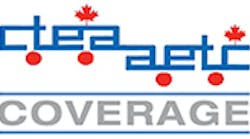They’re working.
That’s the conclusion of Chuck Brodie, sales and service technical specialist for Meritor WABCO, when he analyzes results of companies that have added advanced safety systems.
In his presentation, “Commercial Vehicle Safety Systems: The Future is Now,” he said that a national logistics company with over 500 locations and over 29,000 employees reports that rear-end collisions are down 87% since using radar-based adaptive cruise control and that rollovers are down over 50%. In addition, a national fleet—which has more than 12,000 trucks on the road and has had roll stability control (RSC) on its trucks since 2004 and OnGuard adaptive cruise control since 2013—reports a 66% reduction in rear-end collisions, 89% reduction in costs, and a significant decreaseBrodie said that 59% of fatal accidents involve the front of the truck, so Meritor put its energy into developing forward collision mitigation systems.
“That’s where we could save the most lives,” he said.
According to a University of Michigan Transportation Research Institute (UMTRI) study that was funded but not conducted by the National Highway Traffic Safety Administration (NHTSA) under a cooperative agreement with Meritor, there are 178,000 tractor-trailer crashes annually, resulting in 3330 fatalities. Of those crashes, approximately 6900 were rollovers, resulting in 200 fatalities.
UMTRI’s study determined roll stability control (RSC) could have eliminated 48% of rollover crashes and electronic stability control (ESC) could have eliminated 25% of loss-of-control crashes. The total economic benefit if stability control were on all trucks: RSC, $1.46 billion; ESC, $1.74 billion.
With that in mind, NHTSA announced a regulatory update on ESC and estimates the mandate will save up to 49 lives, prevent up to 1759 crashes each year, and provide economic benefits of more than $300 million annually. The final rule was issued in June, with full stability control systems (roll and directional control) to be installed on most truck-tractors and certain large buses. Straight trucks are not covered. By August 2017, it will be required on three-axle truck-tractors with front-axle GAWRs of 14,600 pounds or less and two rear-drive axles with a combined GAWR of 45,000 pounds or less. By August 2019, it will be required on all remaining truck tractors.
That got the attention of Transport Canada, which reported that from 2005 to 2012, there was an annual estimated average of 2810 truck-tractor collisions that included a rollover or loss of control event, 819 of which caused injury and 70 of which caused fatalities. Transport Canada proposed introducing a new safety standard to the MVSR that would mandate the fitment of ESC systems on certain truck-tractors and buses. These requirements would be aligned with those of the United States.
So how does stability control work?
SmarTrac stability control functionality is integrated within the pneumatic ABS platform. There are two stability control systems available: RSC, which covers roll stability and yaw control; and ESC, which covers yaw control.
Brodie said RSC monitors the vehicle’s rollover threshold and activates to slow the vehicle when the threshold is exceeded, reducing downtime caused by vehicle rollover, vehicle and cargo replacements, clean-up costs and possible fines, and insurance costs, preserving customer goodwill and future business.
ESC includes RSC with the added benefit of yaw control, assisting directional control of the vehicle in slippery road conditions or taking an evasive action, and reducing the chances of a jack-knife and drift-out through selective braking of the tractor and trailer.
RSC mitigates roll risk by engine control, retarder control, and brake control. ECS assists with roll and yaw instabilities such as under-steer and over-steer.
Trailer roll stability support is aided because the system continuously monitors load status and lateral acceleration for optimized performance. Brake pressure is applied as needed to maintain stability control and mitigate potential for rollovers.
NHTSA and the Virginia Tech Transportation Institute (VTTI) performed a naturalistic field study on collision mitigation systems (two different systems), using 169 drivers with CMS-equipped trucks covering over three million miles and 110,000 hours of driving. The objectives were to evaluate the reliability of CMS systems, assess driving performance over time and overall driving behavior, provide data on real-world conflicts, and generate inputs for a safety benefits simulation model.
Brodie said the National Transportation Safety Board (NTSB) is pushing for collision mitigation legislation, and NHTSA agrees that these systems have the potential to save lives by up to 44% and injuries by up to 47%. NHTSA accepted a safety advocate petition in October to determine if regulating CMS is warranted.
Brodie said that with collision warning, audible and visual warnings provides detection of developing rear-end collisions and alert the driver: 1.5 seconds following distance warning and 2.7 seconds time-to-collision warning.
Adaptive cruise with active warning provides adaptive cruise for both deceleration and automatic resume. It assists the driver in maintaining a 3.6-second following distance. It also provides sequential deceleration activation: torque reduction, retarder control, and foundation braking.
Collision mitigation has an “always on” emergency activation, calculates impending collision, haptic warning and evasive maneuver check, stationary object braking, and 50% full brake apply. It functions at speeds over 15 mph. There is an auto disengage if the driver takes appropriate action, improved object tracking and resolution, and a high-resolution, multi-beam, and long- and short-range scan. ♦
For more information on Canadian Transportation
Equipment Association check out CTEA.











